A Revolution in Dust Collection
The industry gets serious about the subject, with safer products for every budget.

Synopsis: The trouble with wood dust is that the most dangerous particles—the very fine ones—are the most difficult to collect. Under 10 microns in size, they hang longest in the air, penetrate deepest into the lungs, and are the hardest for the body to eject. Our corner of the woodworking world has been slow to tackle the problem of adequate dust collection, but more and more manufacturers are getting serious about the subject, and effective solutions are now available for every size shop. Learn the differences between the cyclone, the single-stage dust collector, and the shop vacuum, how to choose the right filter, and how to use a dust separator to make your system the best it can be.
In 2002, wood dust went from being a nuisance to an official health risk. That’s when the U.S. government put it on their list of “known carcinogens,” linking it to a variety of nose, throat, and lung cancers. But it has taken our corner of the woodworking industry a while to catch up with reality.
The best way to manage dust is to collect it at the source, and one of the industry’s first important realizations was that the dust ports were sadly lacking on most woodworking tools, and nonexistent on others. That was pretty easy to fix, and the improvements have been steady and significant. So before you spend money on ceiling-hung air filters or expensive respirators, go to the source of the problem. Connect your dust collector and shop vacuum to every possible power tool. If you are buying new tools, look for manufacturers that make dust collection convenient and effective. For your existing tools, take a day in the shop to improve the ports. Fine Woodworking has done lots of articles on this topic.
The filtration story
Fifteen or twenty years ago, if you collected dust at all, you probably did it with a single-stage collector and a 30-micron polyester bag. Those porous bags act like fine-dust delivery systems, blasting out a cloud of the most dangerous stuff at head height. The irony is that people who didn’t bother with dust collection at all, leaving big piles of sawdust under their tablesaws, were probably safer!
The trouble with wood dust is that the most dangerous particles, the very fine ones, are the hardest to collect. Under 10 microns in size, they hang longest in the air, penetrate deepest into the lungs, and are the hardest for the body to eject.
So the tool companies knew they had to get serious about filtration. Felt bags were an early response, borrowed from the industry. But the finer the felt, the taller the bag needed to be in order to have enough surface area for good airflow. There’s room for that in a factory but not a small shop. Enter the pleated filter, which packs hundreds of square feet of surface area into a small canister. You see these now on the latest cyclones, single-stage dust collectors, and shop vacuums, and they certainly are a major upgrade from the filters of the past. But for everything but the cyclones, there is a problem: The filters can only get so fine before they start clogging and killing airflow.
Why the cyclone is still best—Filters work best on two-stage collectors (like cyclones). A two-stage system catches most of the dust before it can get to the filter. That means the filter can be much finer.
On single-stage dust collectors (and most shop vacs), most of the fine dust reaches the filter, so the very finest pleated filters will quickly pack with dust and start killing suction. At least five manufacturers of single-
stage dust collectors told me the same thing: that they had to stop at 2-micron pleated filters when outfitting those machines. On the other hand, cyclone collectors can have state-of-the-art filters that capture particles as small as 0.3 microns.
(For the bottom line on filter ratings, see “The truth about filtration,” on p. 59.)
So my first piece of advice is to buy a cyclone dust collector if you can. While the first cyclones for small shops were big, expensive, stationary machines, requiring long hose or rigid-duct runs to reach all four corners of a shop, almost every cyclone manufacturer now makes compact, roll-around models, and many are under $1,000.
Separators for the rest of us
I would love to trade up for a cyclone collector, but I recently exhausted my marital capital on a bigger bandsaw and a planer/jointer with a segmented cutterhead. So I have the same setup you probably have: a single-stage collector and a shop vacuum.
I’ve done my best to upgrade them. I put a “2-micron” cartridge filter on my dust collector and replaced the standard filter on my vac with a HEPA model (the finest filtration available). But the HEPA filter came with a cost: I have to bang it against my trash can regularly to unclog it and restore the vacuum’s suction. That’s not only a pain, but it also fills my head with the same fine dust I’m trying to avoid. And I’ve known for some time that the 2-micron filter on my collector was not up to snuff.
The light went on for me when I recently reviewed Oneida’s new Dust Deputy (Tools & Materials, FWW #207). It is a small plastic cyclone separator for shop vacuums, and I was astounded at how clean it kept my HEPA filter, and how much more powerful the airflow was as a result.
Dust separators are nothing new, and they are made for both shop vacuums and single-stage dust collectors. The common type is not much more than an inlet and outlet that attach to the top of a barrel. Dust reaches the barrel first, where the larger particles spin around and settle out before the air passes out of the barrel and into the dust collector itself. Oneida’s little cyclone is just a new type of separator.
My experience with the Dust Deputy got me thinking: Could I upgrade the cartridge filter on my single-stage dust collector and then install a separator to keep that filter from clogging constantly? Or do I have to spring for a cyclone to be truly safe?
Testing, testing
To answer these questions and more, I started researching this article. I spoke with product managers from eight companies; brought in the best cyclones, single-stagers, shop vacuums, aftermarket filters, and dust separators for testing; and enlisted the help of FWW shop manager Bill Peck, a retired engineer. He dug our pitot tube and digital manometer (devices for measuring airflow) out of storage, and borrowed bags of dust from a local shop.
No surprise: Cyclones rule—First, Peck measured the initial airflow on every dust collector and vacuum to get a baseline for each with a clean filter. Then he turned them on and sucked up enough dust to fill each one to capacity, measuring flow the whole time. That told us that the experts are right about cyclones: They work better than any other type of collector. While the airflow/suction on the other dust collectors and vacs dipped up to 40 percent as their filters clogged, the filters on the cyclones stayed clean and the airflow barely wavered.
How to test single-stagers?—After seeing what a dust separator did for my shop vacuum, allowing it to have a much finer filter without clogging, I couldn’t wait to try out the separators made for single-stage dust collectors. That’s when we hit a roadblock: No one makes an aftermarket filter for single-stage collectors that are any better than the standard-issue models. (But that’s about to change. See “Better filters are on the way,” opposite page.)
So we couldn’t upgrade the filters on the single-stage collectors, but we could do two things that would get us very close to a definitive answer. First, we could test the effect of a dust separator on a single-stage collector with its standard pleated filter in place. If the separators worked well for those, they should help even finer filters too. Second, we could do the full test on our army of shop vacuums, since there are dust separators and upgraded filters available for all of those.
Separators work wonders on single-stage collectors—We started by testing a number of typical single-stage collectors, trying them without a separator in place, and the results were sobering: Airflow dropped by an average of 40% after filling the bags just once. One has to assume that number would be even higher with finer filters. Then we picked a typical performer, the Jet DC1100CK, and tried it with various dust separators. With the best separators, the airflow hardly budged! By the way, Jet makes a “Vortex” version of its single-stage collectors, and the one we tested recently (see “Tools & Materials,” FWW #222) kept its filter clean without the need for a separator.
We also tested the effectiveness of those internal flappers that manufacturers have included on their cartridge filters. They worked great, too. A few spins of the handles this way and that unpacked the pleats and brought the airflow back to normal. Blowing compressed air through the pleats also worked very well, and won’t abrade the filter media the way flappers might. We also found that a full bag drives the dust swirl higher, clogging the filter more quickly, so we recommend emptying the bag when it is half full or so.
Separators are a must-have for shop vacuums—The next test was tougher. We put both standard and HEPA filters onto a number of shop vacuums, sucked up gallons of dust, and measured the flow. Sure enough, the HEPA filters clogged more rapidly than standard models, just as I experienced in my own shop. Then we attached the separators, and they did their magic once again, keeping the filters clean and flowing free.
By the way, our tests showed that adding a separator does steal a small amount of initial airflow, but that loss is vastly outweighed by their advantage once you start pouring dust into the system.
The bottom line for safe woodworking
If you want to be safe from fine wood dust and have a cleaner shop in general, you should focus on two things: Bringing the proper amount of suction to the source and putting the finest filtration you can buy at the other end.
Choose the right power plant—Your primary source of suction for woodworking machinery should be a dust collector, not a shop vacuum. That’s because you need as much as 700 cfm of airflow at the end of the hose for larger machines. But it is possible to overbuild your system. Too much air pressure is actually a bad thing, since it can force dust right through a fine filter. So unless you are installing a full-shop system, with a stationary collector and permanent duct runs to every corner, a 2-hp dust collector (either cyclone or single-stage) with a 12-in. impeller is probably right for a basement or garage shop.
With anything smaller, and even for 2-hp collectors, I recommend keeping the biggest machines as close as possible to each other to keep hose runs shorter (long runs add friction and slow airflow).
Check your filters—If you can afford it, get one of the new compact cyclones, with a filter that has been rated by a reputable third party. We found three manufacturers with certified, state-of-the-art filters—Grizzly, Oneida, and Penn State. And filters from those companies can be purchased as accessories and retrofit onto an existing cyclone. But other manufacturers are upgrading all the time, so check websites for current stats and testing info.
If a single-stage collector is a better fit for your budget, or if you already own one, consider the upgraded filters coming from Grizzly and Oneida. Most collectors have similar dimensions and designs, so there should be an aftermarket filter that will fit yours. After upgrading, consider adding a dust separator to keep the filter clean and the airflow powerful.
Of course, no matter what type of collector you get, you’ll need a shop vacuum that can go where its big brother can’t. Put a HEPA filter on yours, or buy a new one with HEPA standard. And unless your vac has some kind of self-cleaning feature (a few have built-in filter shakers), add a dust separator to keep that HEPA filter from clogging and killing airflow. By the way, while doing all this testing, we ended up testing the best new vacuums (see “Tool Test: Shop Vacuums,” pp. 70-75).
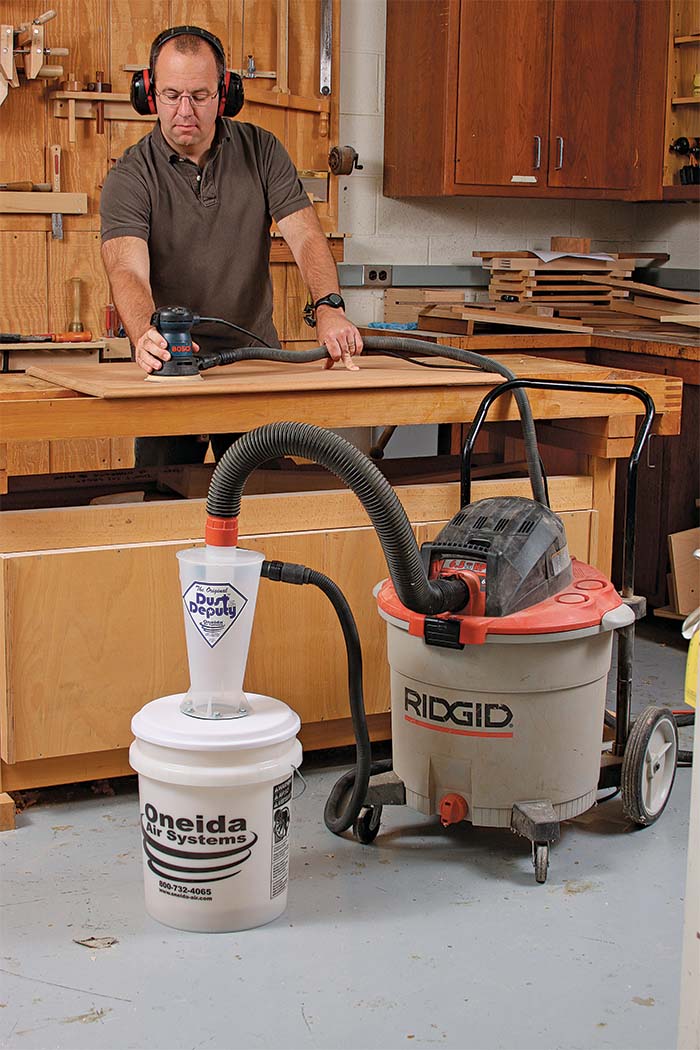 Small cyclones, tiny cyclones
Small cyclones, tiny cyclones
One of the breakthroughs in dust collection involves downsizing. There is no doubt that the cyclone is the best way to collect dust. New portable models (above) are a more affordable option for small shops, while even smaller versions work wonders as dust separators for shop vacuums (right) and single-stage dust collectors.
Why two stages are better than one

The cyclone is king
A cyclone has two stages. Dust is drawn first into the cyclone itself. All but the very finest particles fly to the outside of the cone and spiral down into a collecting bucket, leaving mostly clean air to be drawn up through the center of the funnel cloud and into the filter stage.

Most collectors and vacs are single-stage
Single-stage dust collectors (and most shop vacuums) draw air and chips directly into the collection area, where they clog filters, choking airflow and reducing suction.

Add a separator to create a two-stage system
A dust separator turns a single-stage collector (or vac) into a two-stage system, grabbing the vast majority of the dust before it reaches the filter, keeping it clean and effective.
Testing clears the air

Cyclones rule

Wonderfully efficient. While the airflow dropped quickly as we sucked dust into the single-stage collectors, it barely budged on the cyclones.
Single-stagers need help
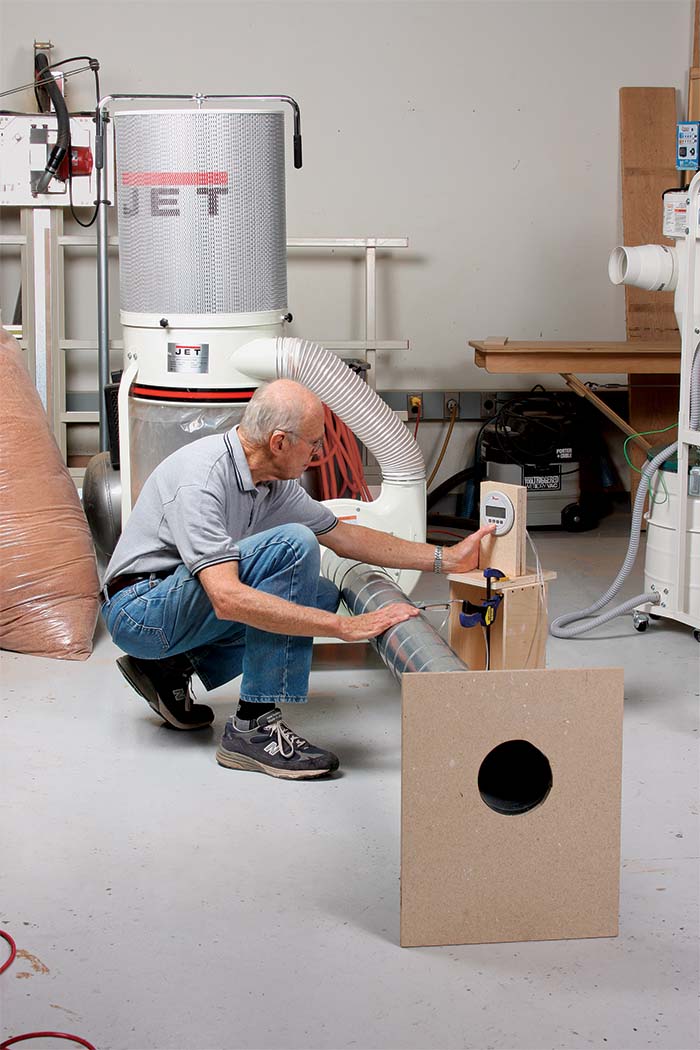
A separator makes a dramatic improvement. Although it sapped a bit of the initial airflow, the Oneida Super Dust Deputy removed 99% of the dust before it reached the filter of this Jet dust collector, keeping the airflow steady. Frequent filter cleaning was also effective (see p. 57)

Separators super-charge Shop vacuums
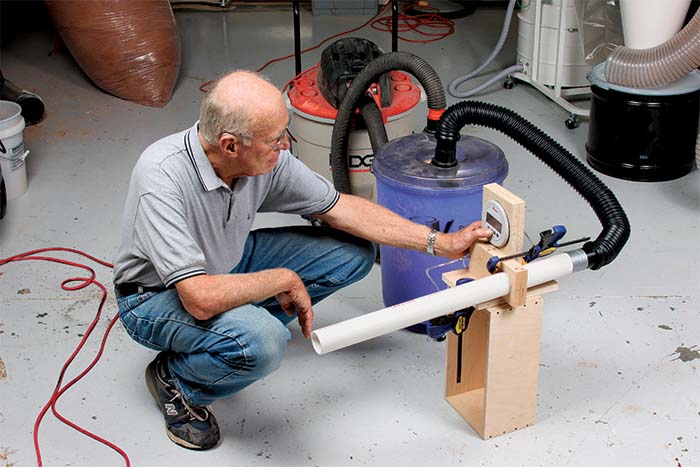
Same cure for shop vacs. We outfitted shop vacuums with HEPA filters and tested them with and without separators. The difference was undeniable, both in airflow and filter conditions. The only vac that maintained its suction without a separator was the Bosch Airsweep (see “Tool Test: Shop Vacuums,” p. 70).
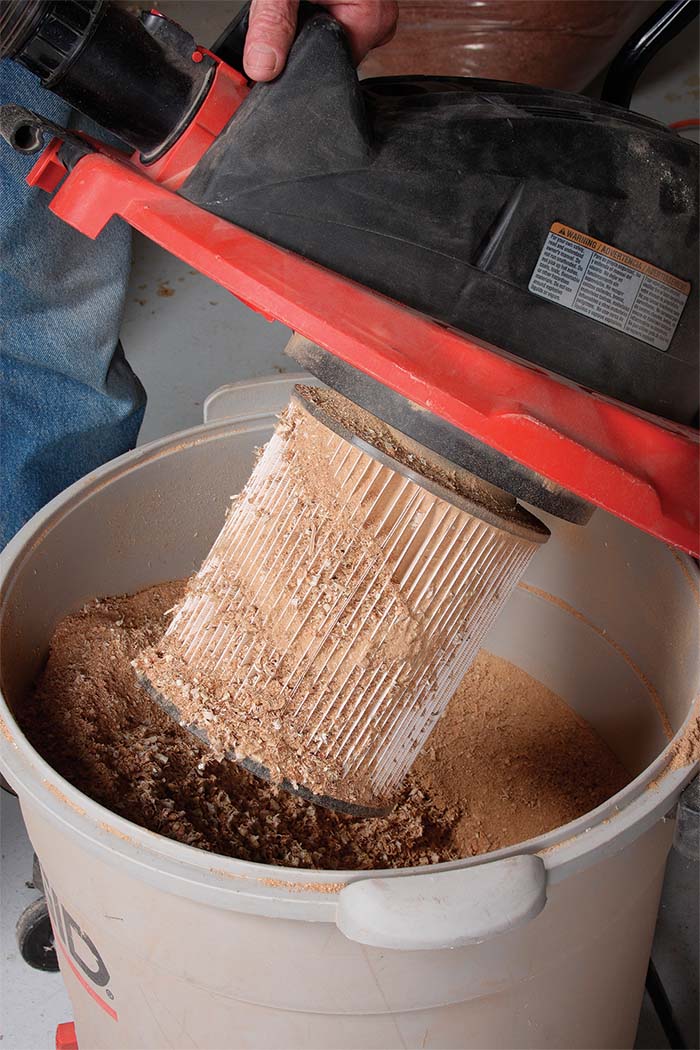 |
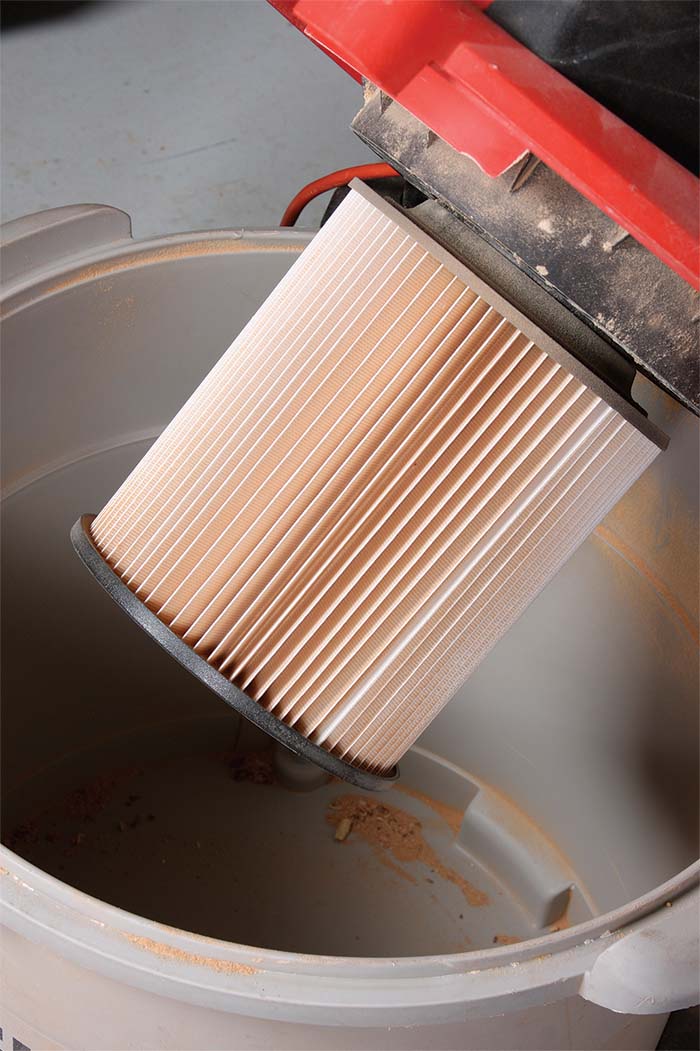 |

A user’s guide
To state-of-the-art dust collection
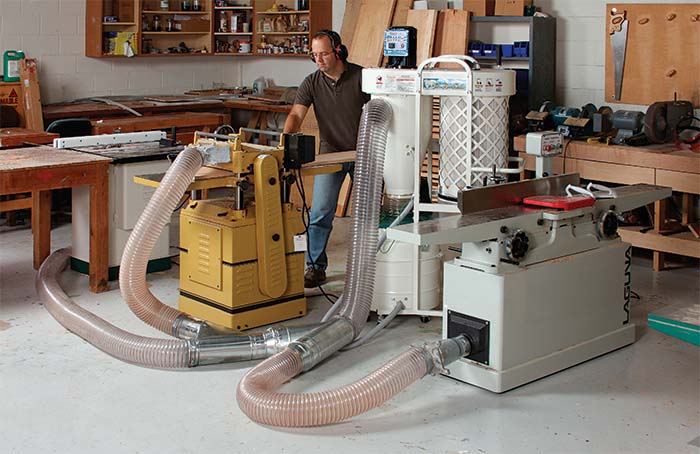
Cyclones: Go portable and choose wisely
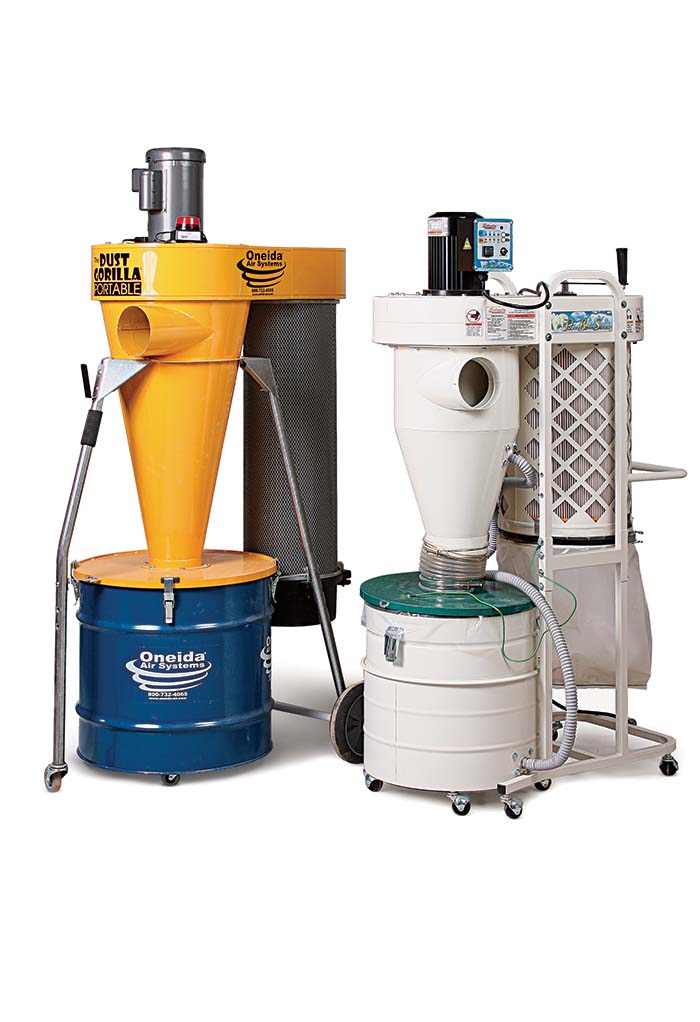
Find a cyclone with a fine filter. Grizzly, Oneida, and Penn State (sold out at press time) are three companies whose cyclone filters are rated MERV 15 or higher (see “The truth about filtration,” on p. 59). Oneida’s HEPA filters are the highest rated.
Or upgrade the cyclone you have Grizzly, Oneida, and Penn State also sell their filters as accessories.
Single-Stagers: Clean frequently or add a separator
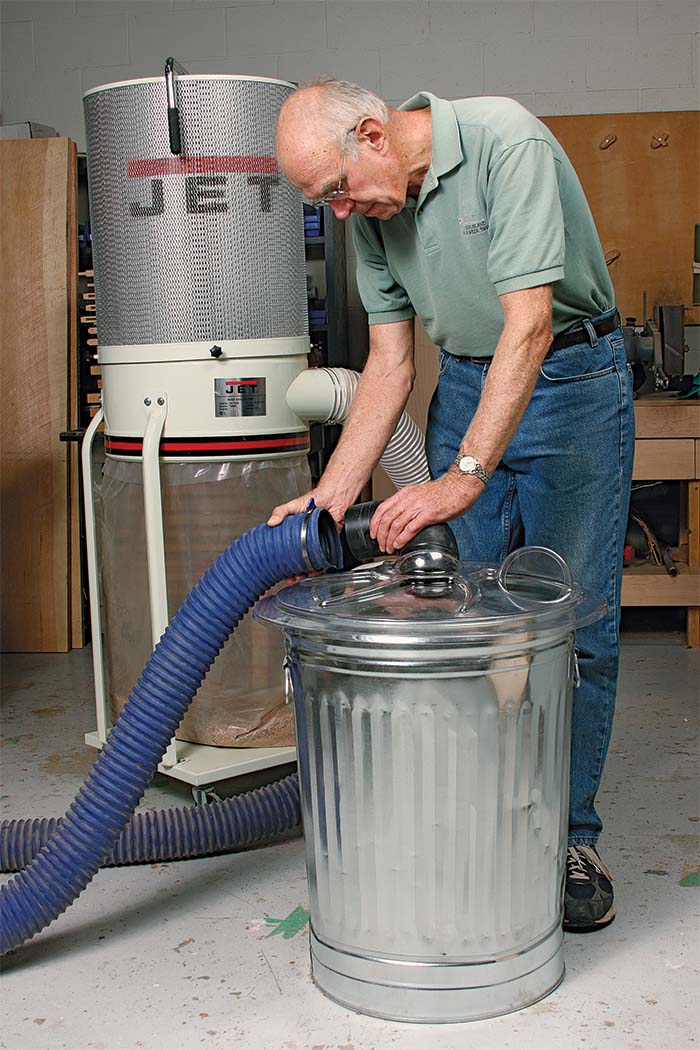
Use a dust separator to keep the filter clean. This Veritas Cyclone Lid is an affordable upgrade for any single-stage dust collector. Separators are also easier to empty than bags are.
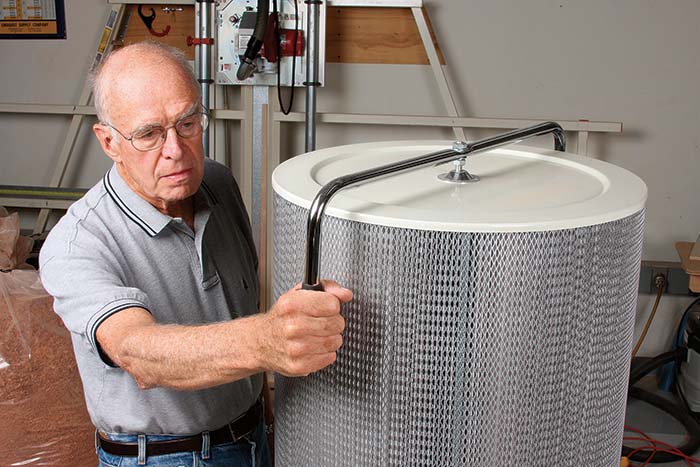 |
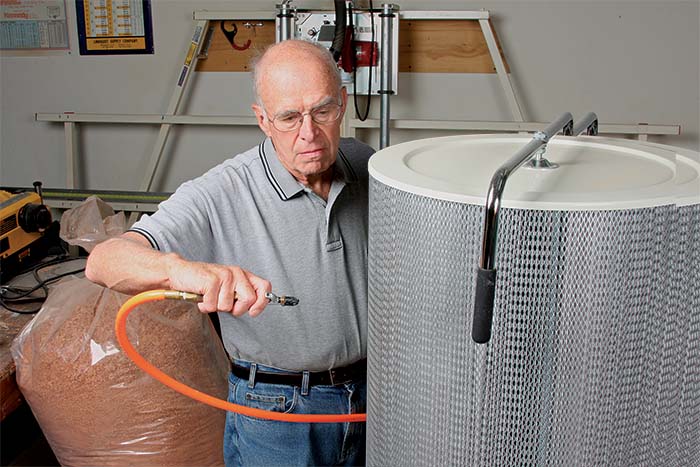 |
Or clean the filter yourself—frequently. Spinning the internal flappers or blowing with compressed air will return the airflow to normal, but you must do it after each woodworking session.
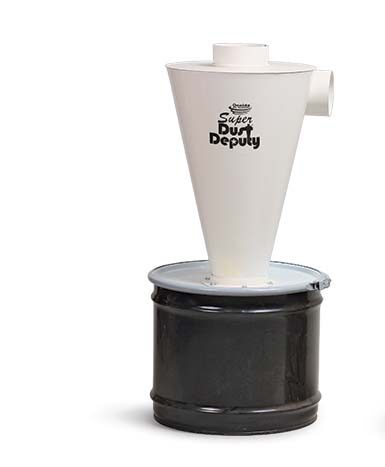 |
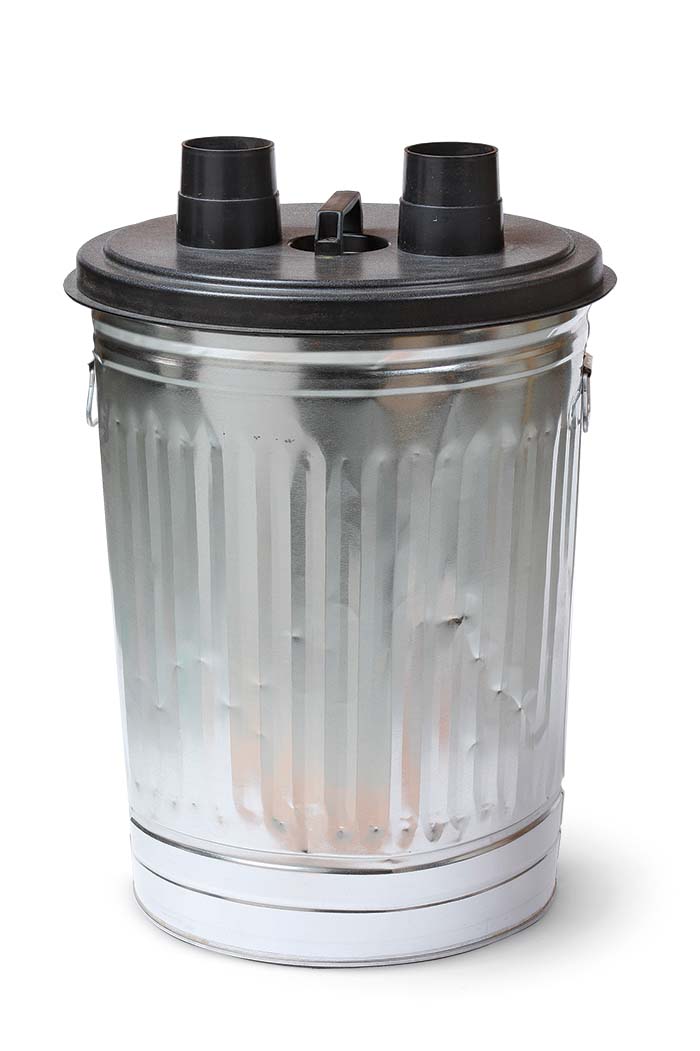 |
|
Super Dust Deputy $220 (requires container) Oneida-Air.com Dust captured: 99% |
Trash Can Cyclone Lid $31.50 (requires container) Woodcraft.com Dust captured: 90% |

Better filters are on the way
As a result of this article, both Grizzly and Oneida have agreed to make and sell upgraded filters for single-stage collectors, with the same filter material used in their cyclone filters. The Oneida FXK011820 HEPA (intro price: $270) is available now, and the Grizzly T23916 ($300) by Jan. 1.
Shop vacuums: Two affordable upgrades make a big difference
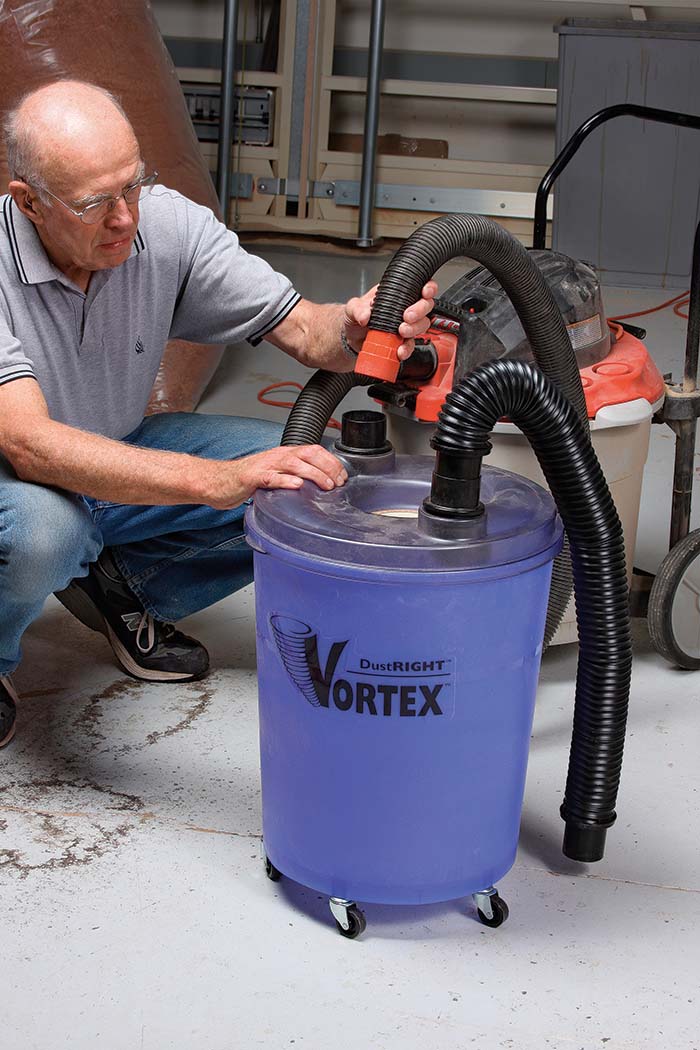
Faithful companion. A dust separator tags along with your shop vacuum, capturing 99% of the dust before it can clog the filter.
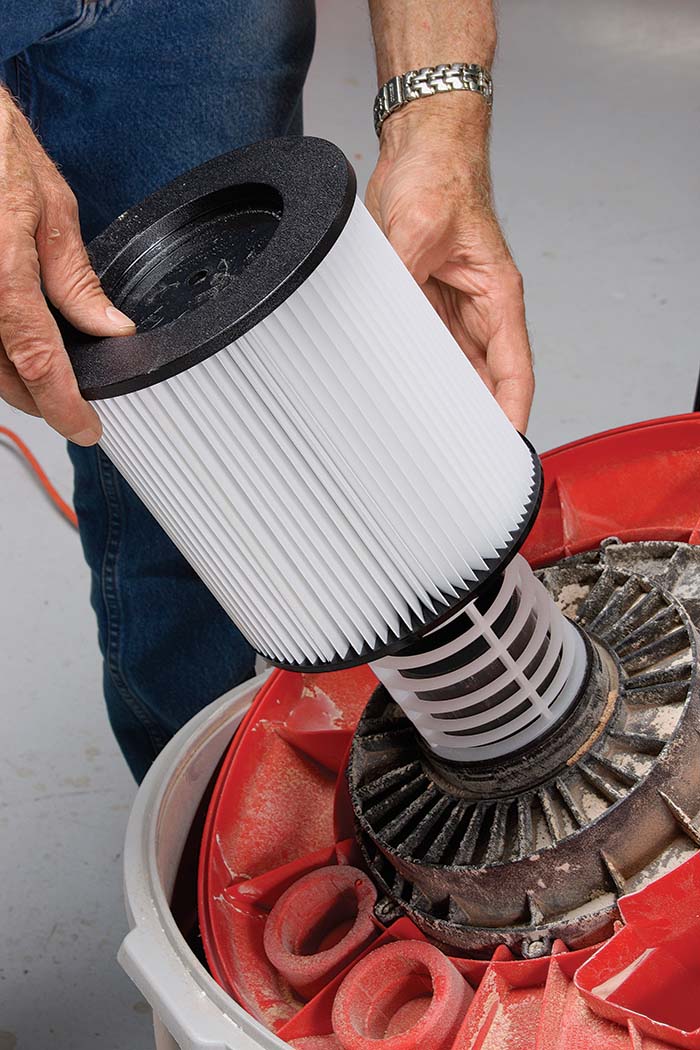
Add a HEPA filter. Certified HEPA aftermarket filters are inexpensive and widely available for most shop vacuums. Go to cleanstream.com for more information. However, without a dust separator (left), a HEPA filter will clog more quickly than a standard one, reducing airflow significantly.
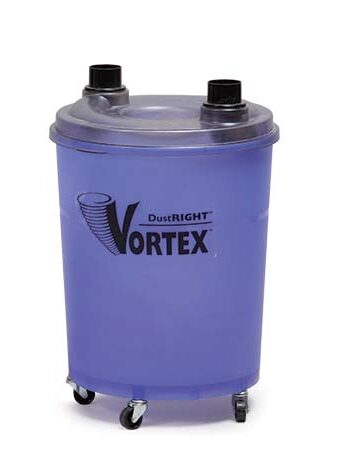 |
Dust Right Vortex $70 Rockler.com Dust captured: 99% We tested three dust separators designed for shop vacuums, and two were extremely efficient, the Oneida Dust Deputy and Rockler’s Dust Right Vortex. The Dust Deputy stopped significantly more of the finest dust before it reached the vacuum filter, but the Vortex is less expensive and has more capacity. |
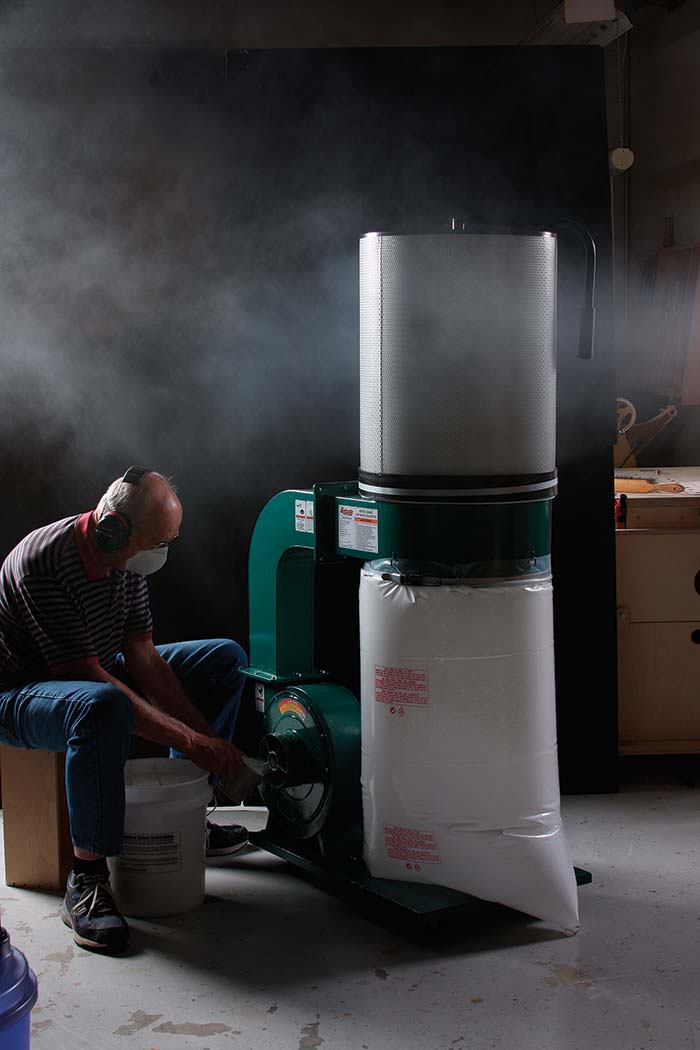 The truth about filtration
The truth about filtration
There is a lot of mystery and misinformation surrounding filtration specs, so I took a closer look. Manufacturers tend to give vague ratings like “2 micron.” If a filter rating doesn’t tell you what percentage of what size particles it can capture, the manufacturer probably doesn’t know exactly. Although the science of filter ratings is new to our corner of the woodworking industry, there are plenty of independent companies in Europe and the United States that can test and rate filter media at very low cost, and a few manufacturers have taken advantage of that.
Ratings are standardized. The widely accepted standard in the United States comes from the American Society of Heating, Refrigerating, and Air-Conditioning Engineers (ASHRAE), and is expressed as a minimum efficiency reporting value (MERV), or as HEPA (high-efficiency particulate air), a rating that exceeds the MERV scale. True HEPA filters capture 99.97% of 0.3-micron particles, which is as small as wood dust gets. For shop-vacuum filters, buy a certified HEPA filter, not “HEPA-type” or anything vague-sounding. For all other dust collectors, look for a filter that is third-party-rated to capture more than 85% of the 0.3-micron to 1.0-micron particles (MERV 15 or higher). We’ve identified most of them in this article. —A.C.
For the full article, download the PDF below:
Fine Woodworking Recommended Products

Ridgid R4331 Planer

Ridgid EB4424 Oscillating Spindle/Belt Sander
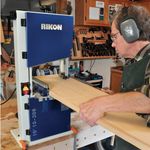
Rikon 10-3061 10-in. Deluxe Bandsaw
The saw has two speeds: 3,280 sfpm (surface feet per minute) for wood and 1,515 sfpm for soft metals and some plastics.








Log in or create an account to post a comment.
Sign up Log in